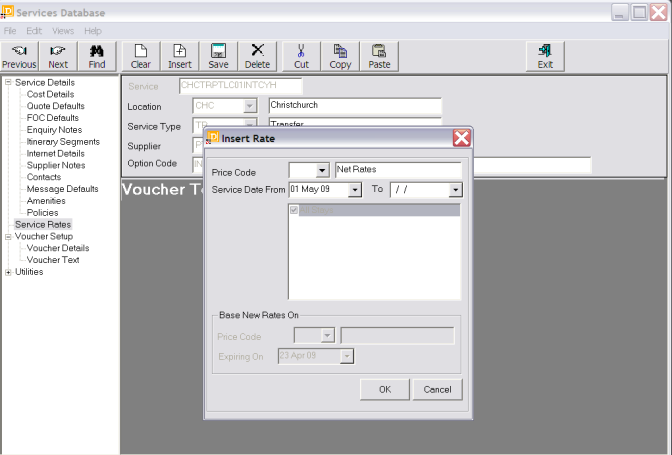
(continued from Voucher Text Screen)
The dialogue box which initially appears enables cost rates and sell rates to be set up on both a Group & FIT basis for date ranges and Price Codes for this Service Option.
Every rate stored in Tourplan has a Start Date, an End (expiry) Date and a Price Code. There are other details stored, but a rate cannot be entered without these 3 pieces of information. There is no limit to the number of future rate periods for each Service Option.
Screen Shot 75: Add New Option Wizard – Group Service Insert Rate Dialogue

Price Code
Select a Price Code (if applicable) from the drop-down list. Price Codes allow different buy and sell rates to be defined for the same date ranges in a Service Option. This is especially versatile in the case where there are different levels of tariff which can be given to agents – e.g., dependant on sales volume. It means that there can be a different price code for each tariff level and in the service option different tariff levels can be set up within the same date ranges. These Price Codes can then be attached to agents in the Tourplan Debtors module which in turn automatically prices Service Options in Quotes and Bookings according to the Price Code/s allocated to the agent. Price Codes (if used) must have been previously setup in the Tourplan CodeMaint module.
Date From
The beginning date for the validity of the rate period.
|
|
Note that if this date is in the future, and an attempt is made to use it in Quotes or Bookings for a service date before the from date, the service will not display as being available to be booked. |
Date To
The expiry date for the validity of this rate period.
For the first rate being entered against a service, the fields in this part of the dialogue will be dimmed out. For subsequent rate periods, these fields can be used to select a Price Code/Expiry Date to ‘copy’ to a new rate period and then edit them as necessary in the next screen.
Screen Shot 76: Completed Insert Rate Dialogue – Group Service
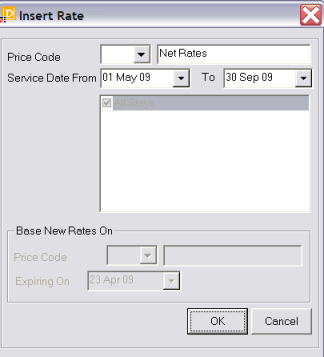
In the example in Screen Shot 76: Completed Insert Rate Dialogue – Group Service above, Net Rates for the period 01 May 2009 to 30 September 2009 are going to be entered.
In subsequent examples, rates for different price codes for the same dates will be entered.
|
|
Once the ‘OK’ button has been clicked on this dialogue, the dates as entered cannot be changed. They can be deleted, extended, or split, but they cannot be edited. |
OK
Click on the OK button to proceed to the Date Ranges screen
Screen Shot 77: Insert Rate - Date Ranges – Group Service - Details Tab
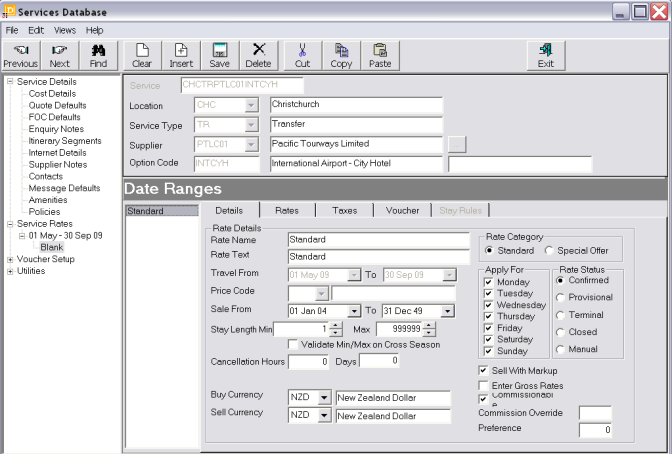
The Date Ranges Screen has five tabs across it:
|
|
These 5 Tabs apply only to the Date Range/Price Code rates currently being set up. |
Rate Name
On rate insert, the default rate name is ‘Standard’. As has been seen in different examples earlier in this document, this field can be edited to reflect the type of rate being entered.
Rate Text
Can be used to enter (e.g.) a special rate code given by Suppliers which can then be produced on supplier documentation.
Travel From/To
The start and end date for this rate. These are the dates previously entered in the Insert Rate Dialogue (Screen Shot 76: Completed Insert Rate Dialogue – Group Service). The dates are display only in this screen.
Price Code
The Price Code applying to this rate. This is the Price Code previously entered in the Insert Rate Dialogue (Screen Shot 76: Completed Insert Rate Dialogue – Group Service) The Price Code is display only in this screen
Sale From/To
The Dates that this rate is able to be sold from/to. These dates default from the Price Code set up (CodeMaint module) but can be overwritten here.
Stay Length Min/Max
These two fields are used to indicate any Minimum or Maximum stay requirements. Examples of use are Special Events where a property imposes a minimum stay; they can also be used in conjunction with Stay/Pay deals which were covered under Stay/Pay and Package Deals.
Cancellation Hours/Days
The Cancellation Policy applying to the rate can be entered in these fields. Entering a value in one field will automatically update the other – i.e., entering 72 Hours will automatically set 3 in to the Days field.
Buy Currency
Select the buy currency from the drop-down list. This should be the currency in which the supplier is to be paid – i.e., the default currency that was entered against the supplier when it was set up. (here). Currencies other than the default can be used if required, but Tourplan will generate the Vouchers and default Accounts Payable transactions to the Buy Currency.
Sell Currency
The Service Sell currency can be different from the buy currency, so the required sell currency can be selected from the dropdown.
|
|
The sell currency set here does not mean that it is the only currency that the service can be sold at. When a quote or booking is set up, the Agent (client) currency will generally determine what the Booking sell currency is. This means that the service could be in Buy AUD (Australian Dollars) and Sell AUD, but can be used in a booking which is being output in USD. |
|
|
If different Buy and Sell Currencies are used in this screen, it must be understood that there is no exchange rate relationship between the two currencies established at Service Option rate level. In other words, there are two values – a buy value and a sell value which happen to have different currency labels on them and at the quoting/booking stage Tourplan’s exchange rate mechanism works out the necessary values based on what currency the quote or booking is being output in. If a service is being bought in New Zealand Dollars and sold in USD then it becomes a relatively simple matter of applying an overall factor to the NZD value which includes Exchange Rate and Markup. e.g. If the general exchange rate between NZD and USD is .70 and a 15% markup is being applied to the service and it is sold in USD, then the factor is .805 - NZD100.00 @ .70 = USD70.00 + 15% = USD10.50 = USD80.50 total. |
Rate Category (Radio Button)
The two buttons here are used when the service is a rate that applies over a period – e.g., valid for 5 days, and additional days are at a rate which is not equal to 1/5 of that rate. i.e., if a five day stay is 500.00, additional days at 110.00, then the 5 day rate is set up as Standard and the additional days as Special Offer. An example is shown in Screen Shot 90: Package Deal – Additional Nights.
Apply For Monday – Sunday
These 7 check boxes can be used to prevent a service being used on certain days of the week. For a standard accommodation service, all 7 check boxes would probably remain checked (i.e., the rate being entered applies for any day of the week). An example of why boxes should be unchecked is when (e.g.) Weekend Rates are being set up. An example of weekend rates is shown in Screen Shot 82: Inserting Weekend/Special Rates.
Sell With MarkupChecking this box will price the Service Option, in quotes and bookings, according to the mark-ups and sell prices entered under the Options Rates tab. If this box is not checked then the Service Option will be priced in the Quote/Booking according to the cost prices entered under the Options Rates tab. This option can be overridden during quoting and booking.
Enter Gross Rates
Checking this box will allow gross rates and commissions to be entered (as opposed to net rates and mark-ups). The cost price will then be calculated.
Commissionable
Leaving this box checked indicates that when this rate is used in bookings and the Agent (client) is being paid a commission, this rate qualifies for the commission. If this box is unchecked, then the rate is non-commissionable.
Commission Override
Any value entered in this field is the commission level applied instead of any commission level that the Agent (client) may be receiving. If the agent is configured to receive 10% commission and the value in this field is 5, then this service will only attract a 5% commission.
Preference
A numeric value can be entered into this field to indicate a Preference ranking for this rate. Services/Rates can be searched for in Quotes/Bookings based on the preference value.
Rate Status
Select one of the Choices:
|
Confirmed |
The rates on this screen have been confirmed by the supplier. |
|
Provisional |
The rates on this screen have not yet been confirmed by the supplier. They are an estimate only – probably based on the previously known and confirmed rates. |
|
Terminal |
The rates on this screen cannot be extended past the “to date”. When this button is selected the Service Option will not be available for bookings or quotes travelling after the “to date”. A message will display advising that the rate has terminated. |
|
Closed |
The rates on this screen are for a “close-out” period e.g. the hotel cannot be booked using this rate/price code and for this date- range/period. |
|
Manual |
No rates will be entered on the Option Rates screen – the buy and sell rates will be entered manually each time this Service Option is used in a quote or booking. This is commonly used for (e.g.), Coach Charter service options where the actual prices will vary depending on the charter length, or Manual Flight Services where the Flight sector values are entered as one total etc. |
|
|
When a ‘Manual’ Rate Status is used and the pricing on the Rates tab is left at 0.00, the expiry date of the rate should be as far in the future as possible – e.g. 31 Dec 2049. If the expiry date is e.g., only 1 year away, then consultants will get an ‘Expired Rate’ message when they try to use the service after the expiry date. Even though the rate is blank, the expiry date will have passed. |
|
|
When the ‘to date’ for Confirmed or Provisional rates have been passed and a) there are no rate periods following and b) the service is used in a quote/booking, a window opens which advises the user that the rates have expired and invite manual entry. |
|
|
When a date range is added to a rate that is terminal, the terminal flag is removed from the original rate period and applied to the new expiry date. |
Screen Shot 78: Insert Rate - Date Ranges – Group Service - Rates Tab
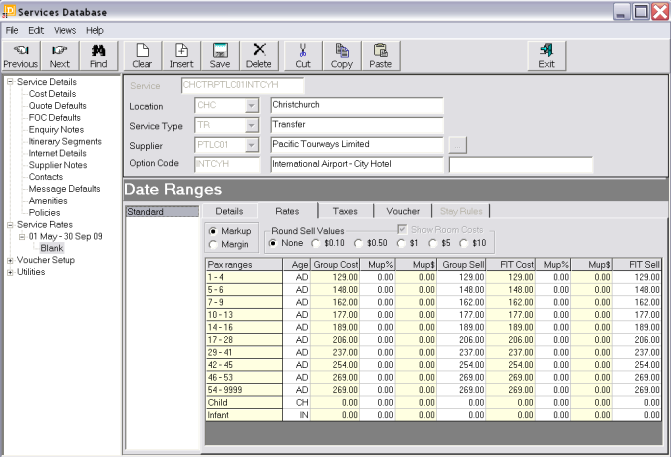
Markup/Margin (Radio Button)
The difference between cost and sell prices can be expressed as either % Markup or % Margin by clicking the appropriate button.
Show Room Costs (Checkbox) (Dimmed)
This setting is not available for non-accommodation services.
Round Sell Values (Radio Button)
Checking one of the radio buttons ‘None’, ‘$0.10’, ‘$0.50’, ‘$1’, ‘$5’ or ‘$10’ will round the sell values accordingly. Rounding is down for less than .5 and up for greater than .5.
|
|
A ‘Round Sell Values’ default setting can be set against Price Codes in the CodeMaint module. |
|
|
The ‘Round Sell Values’ apply to both Group Rates and FIT Rates. |
Pax Ranges
The Pax Ranges column displays the Pax Range numbers entered in the Screen Shot 65: Add New Option Wizard - Quote Defaults Screen. Additional Adult, Child Supplement and Infant Supplement also display as well as any Extras.
Age
This column could more correctly be called ‘Age Category’. It has a separate row for AD (Adult); CH (Child) and IN (Infant) for the Main Option costs and for each of the Extras defined.
Group Cost
This column is used to store the Group Cost rates from the supplier.
Mup%
This column enables (optionally) a markup percentage to be entered which will be used to calculate the Group sell price.
|
|
A markup % can be attached to a Price Code (via CodeMaint module) and if attached, it will automatically default to this column. |
Group Sell
Either enter the Group selling price, accept the price calculated by the Markup percentage, or edit the calculated value. This rate will be used in the Tourplan PCM and Group Booking programs, and is the rate used when the “Sell with Markup” flag described here is checked.
FIT Cost
This column is used to store the FIT Cost rates from the supplier.
Mup%
This column enables (optionally) a markup percentage to be entered which will be used to calculate the FIT sell price.
FIT Sell
Enter the selling price to be used in the Tourplan Fastbook program.
|
|
A markup % can be attached to a Price Code (via CodeMaint module) and if attached, it will automatically default to this column. |
|
|
In the example being created, the ‘Net Rates’ price code will have no markup attached at this level – i.e., the cost and sell rates for both Group & FIT rates will be the same. Mark-ups will be applied when a different Price Code is added to the Date Range. |
1 – 4
The cost and sell rates for Group and FIT for the 1 – 4 seat vehicle are entered on this row.
5 – 6
The cost and sell rates for Group and FIT for the 5 – 6 seat vehicle are entered on this row.
7 – 9
The cost and sell rates for Group and FIT for the 7 – 9 seat vehicle are entered on this row.
10 – 13
The cost and sell rates for Group and FIT for the 10 – 13 seat vehicle are entered on this row.
14 – 16
The cost and sell rates for Group and FIT for the 14 – 16 seater vehicle are entered on this row.
17 – 28
The cost and sell rates for Group and FIT for the 17 – 28 seater vehicle are entered on this row.
29–41
The cost and sell rates for Group and FIT for the 29 – 41 seater vehicle are entered on this row.
42 – 45
The cost and sell rates for Group and FIT for the 42 – 45 seater vehicle are entered on this row.
46 – 53
The cost and sell rates for Group and FIT for the 46 – 53 seater vehicle are entered on this row.
54 - 9999
The cost and sell rates for Group and FIT for more than 53 pax are entered on this row.
|
|
Note that the 54 – 9999 cost is the same as the 46 – 53 cost. This means that if more than 53 pax are in a quote or booking that uses this service, then the system will cost 1 vehicle for up to 53 pax and an additional vehicle(s) for every multiple of 53 pax at the rates specified in this row. |
Child
The cost and sell rates for a child if the supplier ALWAYS charges for a child for this service are entered on this row.
Infant
The cost and sell prices for an infant are entered on this row. if the supplier ALWAYS charges for an infant for this service.
Extras Rates
The items listed in this table are based on the extras setup in the Quote Defaults screen for this Service Option.
Enter the Extras cost and sell rates for adults, children and infants as required.
|
|
A ‘Round Sell Values’ default setting can be set against Price Codes in the CodeMaint module. |
|
|
Remember when entering the rates, if tax is involved, then the values entered into the Option Rates fields must reflect the Tax Inclusive/Exclusive setting from the Screen Shot 32: Add New Option Wizard - Cost Details Screen. Taxes in general are discussed in more detail here. |
|
|
The layout of the Option Rates screen will change if the Buy and Sell currencies are different - examples of the different currencies screen is shown here. |
|
|
NB: All rates and details depicted in this document are examples only and do not reflect any actual rates or conditions that may or may not be offered by any named supplier. |
Screen Shot 79: Date Range Taxes Screen – Group Service
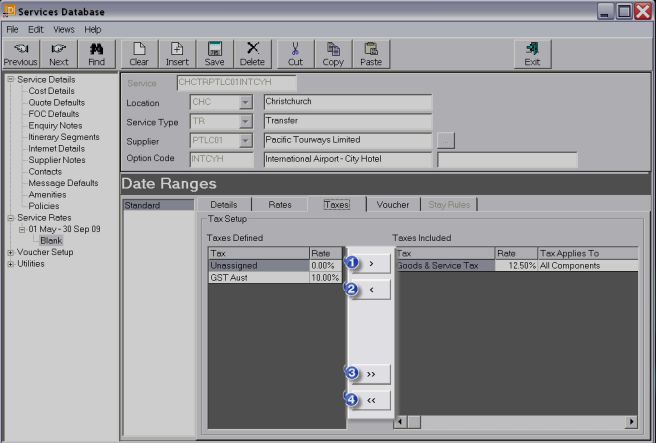
 Available taxes display in the ‘Taxes Defined’ column. To add a tax to the ‘Taxes Included’ column, highlight the tax and click this button.
Available taxes display in the ‘Taxes Defined’ column. To add a tax to the ‘Taxes Included’ column, highlight the tax and click this button.
 Any taxes which have been attached in error can be removed by highlighting the tax in Taxes Included column and clicking this button.
Any taxes which have been attached in error can be removed by highlighting the tax in Taxes Included column and clicking this button.
|
|
The tax to apply to the rate must be attached here, regardless of whether the rate entry is Tax Inclusive or Tax Exclusive. |
 To add all defined taxes to the ‘Taxes Included’ column, click this button.
To add all defined taxes to the ‘Taxes Included’ column, click this button.
 To remove all taxes from the Taxes Included column, click this button.
To remove all taxes from the Taxes Included column, click this button.
|
|
To view which components of the service the tax applies to, double click the tax while it is in the Taxes Included column. |
|
|
A word about taxes and Tourplan. In general, taxes should only be applied here if there is a responsibility to account for the tax. This would normally be some type of Input/Output tax (VAT, GST etc.). If there is no accounting responsibility associated with the tax,(i.e. Sales Taxes, Bed Taxes etc.) then the cost/sell values entered in the Option Rates screen can include the tax. This method however raises issues of rate maintenance when the tax rate changes, so the taxes can be set up in the CodeMaint Module and then applied here. In doing this, when the tax rate changes, a new tax can be set up with the new tax rate and the Rate Maintenance Utility Program can be used to add the new tax and update the rates. |
Screen Shot 80: Date Ranges - Voucher Text – Group Service
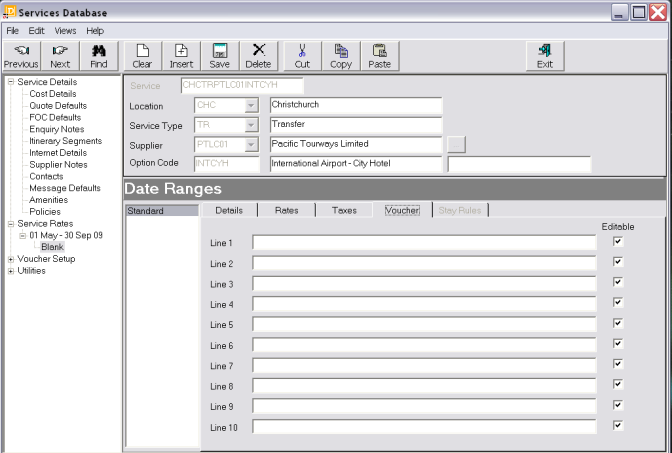
This screen enables a further 10 lines of voucher text to be added which are specific to this date range/price code! This allows text and detail which (e.g.) must be specified on vouchers to qualify for the rate, to be entered.
Lines 1-10
Each line of text is numbered and held in a separate field in Tourplan. This is very useful when designing Tourplan messages because, for example, an agent message format can be designed which uses only line 1 of the voucher text and a supplier message which uses both lines 1 & 2 of the voucher text.
Editable
Determines whether or not this line of text is allowed to be edited on voucher output.
|
|
Using the Voucher Text is optional i.e. useful voucher formats can still be created without this extra Service Option information. However if the Voucher Text is used, then ensure that common information is entered on each line for the Service Options. |
This tab is dimmed out and not available when the Cost Details Screen field ‘How Many 24hr Periods …’ is set to zero.
When all entries on the 4 Date Ranges tabs have been completed click the ‘Save’ button in the Button Bar.
If additional date ranges and/or Price Codes are to be added, the detail can be found here.